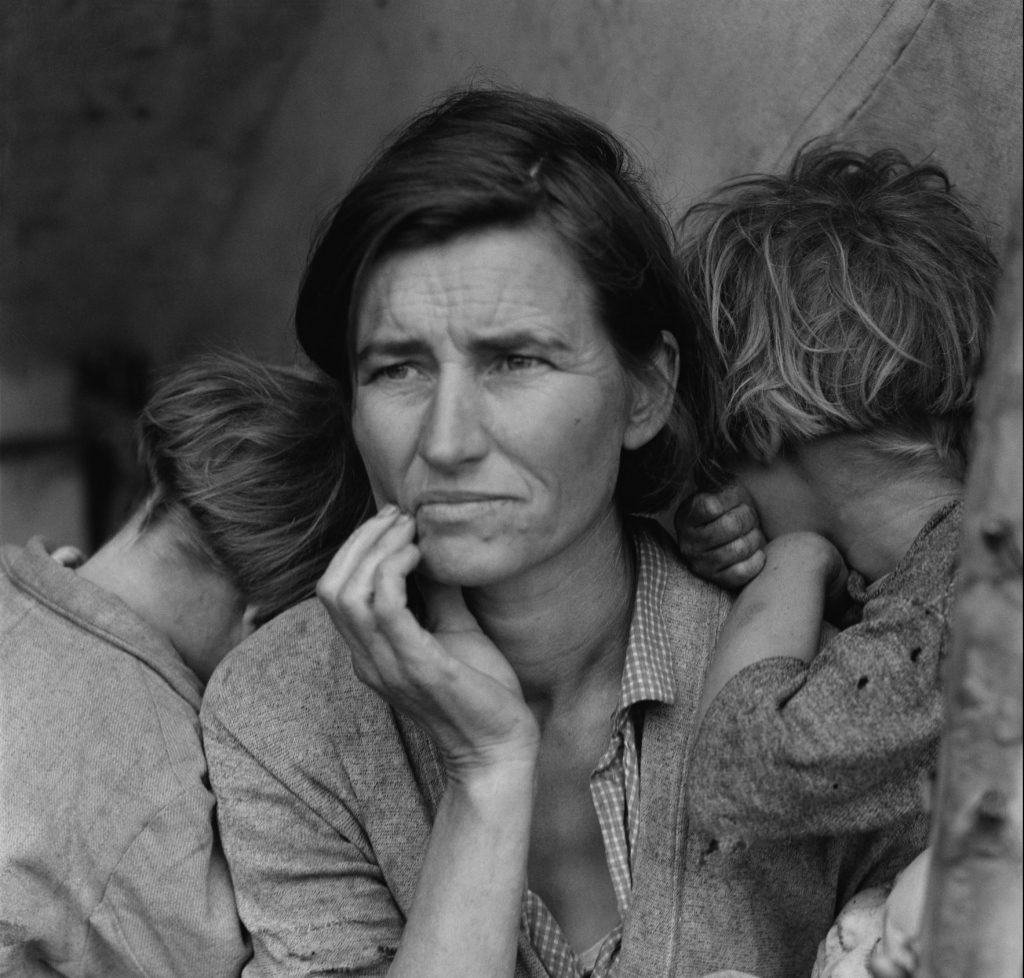What can a single image possibly say about our complex world? Of course, one picture can’t possibly capture everything. All of the tragedy and despair or all of the celebrations and joyful moments can hardly be captured in a million pictures. So, what difference can one picture really make? Documentary photographer, Dorothea Lange, set out with a simple goal in mind: to document the lives of the ordinary people in the world around her. In doing so, she inadvertently brought about drastic change through the increase of awareness of poverty and the conditions people were forced to endure. Lange influenced millions through the use of one single picture, and, that influence has and will continue for decades in the future.1
Lange found her life’s work and passion as a photographer in the 1930s, following the path of a common photographer in capturing people’s portraits and selling them to make a profit. While she enjoyed her work and was obviously very skilled, she always thought of herself as more of a historian than a true artist. As her career in portraiture continued, she improved her skills and came to open up a studio of her own in San Francisco, California. Here, she continued to perfect her craft, and she shared her talent with those among the wealthier classes of her society. It didn’t take long, however, for her to realize that her picture-taking skills could be used for much bigger, much greater, and overall, much more important things.2
In the midst of her successful portrait-focused career, the Great Depression struck and ravaged the lives of Americans far and wide. Lange, who originally, “would have thought it enough to take a picture of a man, nothing more,” quickly came to readjust her mindset upon seeing the pain in the world around her, and instead, decided that she “wanted to take a picture of a man as he stood in the world.”3 In 1933, a time in American history categorized by increasing tension and unbearable poverty in the lives of the average worker, Lange made what would come to be a life-changing decision: a drastic change in her creative mindset from elegant portraits to exposing the conditions of poverty. This single change in her life led her to become, undoubtedly, one of the most influential documentary photographers of the Great Depression.4

In May of 1935, with her newfound purpose of documenting the suffering around her, Lange became an employee of the Resettlement Administration (RA), later known as the Farm Security Administration (FSA). The goal of the RA was to bring to light the struggles of rural poverty in the country through the use of photographs. They found that sharing the conditions and hardships of life through photographs was much more impactful than any written reports, because the audience could see situations with their own eyes, which they may not have ever had the chance to see. The RA used this method of documentary photography because they recognized how powerful it could be and they needed to gain support for their projects. Lange’s job with the RA was demanding and required her to travel across the country to places that many had never heard of or even knew existed at all.5 Needless to say, she completed meaningful work and had many adventures throughout her time with the RA.

On one such adventure, on a rainy day in March of 1936, Lange had just finished another one of her photography excursions in California, and had packed up all of her equipment and supplies to begin her more than seven-hour drive home to her family. The drive started off dull and uneventful as she pushed ahead in the pouring rain. Occasionally, there were other cars and signs on the side of the road, but nothing out of the ordinary for the small San Luis Obispo County road. “PEA-PICKERS CAMP” one sign read. She considered stopping, thinking she would document more of the harsh conditions in the rural area, but instead, decided against it, knowing she still had a long trip ahead of her. While the sign and the camp became further and further behind her, they never left the forefront of her mind.
As she drove on, she thought to herself, questioning what could have been so special about that camp. It was just another pea-pickers camp, like the others she had already seen and taken pictures of. Why should she care about another one? It couldn’t possibly be that different from the ones she’d already seen. She would probably just drive in to find the same suffering and poverty she’d seen at the others. What difference would it make if she just drove past this one camp? Nobody even knew it existed anyway, so it wouldn’t make a difference, right? After getting lost in this inner argument, trying in every way possible to convince herself why she should not turn around, Lange almost unconsciously made a U-turn twenty miles past the sign and began to drive back to the camp.6
Upon reaching the camp that she had almost convinced herself to leave behind, Lange was drawn to one woman in particular. She didn’t ask for the woman’s name, or anything about her history or how she came to work at the pea-picker camp. Lange simply saw this kind of information as irrelevant to achieving her goal, which was to highlight the horrendous conditions and intense poverty of the Great Depression. While she didn’t learn much about the woman, she did learn that she was a mother of seven, living in a makeshift tent surviving mostly on frozen vegetables and small birds. The woman and Lange talked briefly, and then Lange proceeded to take a total of five pictures of the mother and several of her children, later saying, “There she sat in that lean-to tent with her children huddled around her, and seemed to know that my pictures might help her, and so she helped me. There was a sort of equality about it.” After spending a brief ten minutes at the camp, with the limited amount of information Lange had on her subjects, and a grand total of five pictures, Lange once again packed up her supplies and continued on her long trip back home.7

Lange’s intuition to turn her car around that day must have been very powerful. Deep down inside she must have known that her choice to go on or to turn around would make a profound difference in her story and in the lives of millions of those struggling around the world. That one, ten minute stop and those five pictures that Lange almost didn’t get the chance to take, later came to shape her entire career. Those pictures are the reason she is remembered to this day, the most famous being titled “Migrant Mother.” This image depicts the mother of seven that Lange met at the pea-picker camp, staring far off into the distance, seemingly lost in thought and isolated, even as she was surrounded by several of her children. Most, if not all, of Lange’s pictures had a recurring theme of separation from society, with an emphasis on the struggling classes and the pain that they had to endure on a daily basis.8 Lange’s “Migrant Mother,” however, displayed this theme so well that it became a symbol of the Great Depression as a whole. The image became an icon of the Great Depression and people in different cultures even began to replicate it to make it relevant to themselves. One picture gave the mother and children Spanish features, while still another gave them black features.9 Her work was so moving that it mirrored the isolated feelings of numerous cultures and became universally accepted and used to try and changed the way these people were being treated. Lange’s “Migrant Mother” slowly became one of the most recognizable and copied images in history.10
- Encyclopedia of the Great Depression, 2004, s.v. “Lange, Dorothea,” by Linda Gordon. ↵
- Allison McNeill et al., Great Depression and New Deal Biographies (Great Depression and the New Deal Reference Library: vol. 2: Biographies, UXL, 2003), 141-142. ↵
- David P. Peeler, Hope among Us Yet: Social Criticism and Social Solace in Depression America (Athens, Georgia: University of Georgia Press, 1987), 62. ↵
- Encyclopedia of the Great Depression, 2004, s.v. “Lange, Dorothea,” by Ed. Robert S. McElvaine. ↵
- Allison McNeill et al., Great Depression and New Deal Biographies, (Great Depression and the New Deal Reference Library: vol. 2: Biographies, UXL, 2003), 144-146. ↵
- Milton Meltzer, Dorothea Lange: A Photographer’s Life (New York, NY: Farrat, Straus & Giroux, 1978), 132-133. ↵
- Dorothea Lange, “The Assignment I’ll Never Forget: Migrant Mother,” Popular Photography February 1960, 1-2. ↵
- Melissa A. McEuen, Seeing America: Women Photographers between the Wars (Kentucky: The University Press of Kentucky, 2000), 110. ↵
- Judith Fryer Davidov, Women’s Camera Work: Self/Body/Other in American Visual Culture. (Durham, North Carolina: Duke University Press, 1998), 5-6. ↵
- Lawrence W. Levine, “The Historian and the Icon: Photography and the History of the American People in the 1930s and 1940s,” In Documenting America, 1935–1943, (Berkley: University of California Press, 1988), 16. ↵



140 comments
Nicolas Llosa
This article was interesting. The emotions the photographs transmit are truly powerful. Dorothea Lange’s work is really special as it portrays the devastation of the Great Depression. It was a tragic time, and the pictures transmit that. You can see clearly the devastation and sadness the people in the pictures are going through and helps us see the level of desperation at that time. Lange’s work was inspiring and has helped me understand the level of devastation of that time.
Kenneth Gilley
What an interesting article! Dorothea Lange’s “Migrant Mother” is one of the most famous photographs in history. While I have seen it many times before, I had no idea of the history behind it. Lange’s deep intuition to turn her car around and go back to the pea-pickers camp is certainly curious. Her decision changed history in ways she certainly never could have imagined.
Jacob Silva
They say images are worth a thousand words without a doubt that phrase holds true with the photography of Dorothea Lange especially with the featured image which is arguably the most famous and well known image in modern history, so much is conveyed in that one singular image. The work of Lange definitely illustrates how hard life was for your average American living during the Great Depression.
Sebastian Azcui
The Great Depression was one of the most if not the most difficult time that the United States went threw. People had no money and each time deflation grew even more. Dorothea with these really powerful pictures demonstrates how was life during the Great Depression and how hard it was living in poverty even though she didn’t do anything to lose her previous economical life. These pictures are really worth 1000 words.
Patricia Arechiga
I remember creating a presentation on the famous image during the Great Depression. The Great Depression was a time period in which not only was the country broken from the outside, but too within. Dorothea Lange was a prime example of what millions of people experienced during this time period. It is beyond heartbreaking seeing children, mothers, fathers and overall families lose themselves due to something that was not necessarily their fault. These images speak volumes.
Addie Piatz
Throughout high school these pictures were used in my english and history classes so i’m quite familiar with them and their meaning. Yet it still amazes me how beautiful and moving they are time and time again. The sacrifices that these woman and children in the photos had to make along with all the families that suffered from poverty. I love that these pictures are still being used today so that we can all remember what these beautiful people had to go through.
Nawaf Almarwaie
this picture considered as one of the most famous picture in the modern history. the hunger, homelessness, shortage in healthcare, and other sad images explain the great depression period, and this photo can explain all of these problems. one of the sad things to me is seeing those kids struggling crying, and trying to survive this situation that they did not choose to be in. moreover, we can see the sorrow in the mother’s eyes because she has nothing to do to dry her children’s tears.
Bianca-Rhae Jacquez
I think these photos are still extremely powerful. Many have heard about what happened to the United States during the great depression, but these photos allowed people then and now to see the true effect that it had on people. Dorothea Lange’s ability to capture these photos is amazing. Looking at them makes me wonder how these kids and this mother felt in this situation.
Cameron Lopez
A simple picture can speak louder than words, they can show the truth in a person or in this case a place or situation. These are great pictures that were chosen for this article that work with it well and let it speak. The main picture obviously shows women and children that are suffering, and the article did a great job in presenting just how much was given and sacrificed to make ends meet. It was a strong article that only the pictures made it even stronger giving the reader the ability to read the text and pause and look and really embrace the picture and set it side by side to the text and let it all connect for a greater understanding. Great job
Sharriah Martinez
Photos can be used to speak volumes. The images chosen for this article are beautiful, they have so much detain and definitely speak for themselves. The images show women and children struggling. this article did a great job in showing just how much was sacrificed to make ends meet. While looking at the images i wanted to know what these people were thinking, feeling and talking about. Thank you for this article and congrats on the nomination. It was well deserved.